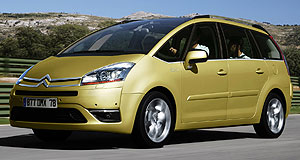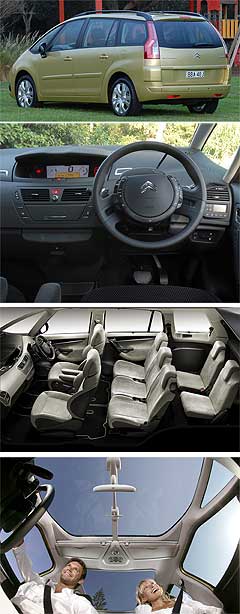First drive: Citroen eyes Odyssey with C4 Picasso
BY BYRON MATHIOUDAKIS | 4th May 2007

On sale now from $39,990, and known as the C4 Grand Picasso abroad, the French-built Citroen is set to steal sales from the likes of the Renault Grand Scenic, Honda Odyssey and Mitsubishi Grandis.
Like these, the Picasso has four doors and a three-row, seven-seater cabin layout, with the last pair of chairs folding flat into the floor.
However, for now, the newcomer is unique in offering a turbo-diesel option. At $44,990, it is Australia’s cheapest to do so in this segment, undercutting Volkswagen’s van-based Kombi TDI by $3000.
This engine – a 2.0-litre HDi common-rail twin-cam 16-valve four-cylinder turbo-diesel producing 100kW at 4000rpm and 270Nm at 2000rpm – is transversely mounted and drives the front wheels.
The sole transmission on offer is an Aisin-supplied AM6 six-speed automatic gearbox with a steering-wheel paddle-shift function.
This combination – unavailable in Europe in the seven-seater Picasso, and devised specifically for Australia, New Zealand and Japan – helps the HDi deliver a combined average fuel-consumption figure of 6.1L/100km and a C02 reading of 159g/km.
Top speed is 195km/h, the 100km/h mark is hit in 12.5 seconds, and the 400m sprint takes 18.5 seconds.
In contrast, the 2.0-litre twin-cam 16-valve four-cylinder petrol engine model delivers 103kW at 6000rpm, 200Nm at 4000rpm, 8.9L/100km, 211g/km of C02, 190km/h, a 12.2 second 0-100km/h acceleration time, and an identical 0-400m result. Plus, the 2.0-litre petrol Picasso must suffice with Citroen’s AL4 four-speed automatic gearbox.
No manual or semi-automatic transmissions are available for now.
Citroen considered bringing in the 80kW 1.6 HDi turbo-diesel engine, but a negligible price difference compared to the 2.0-litre unit scuppered that idea. One insider suggested the gap would have only been around $200.
As the model name suggests, the C4 donates much of its underpinnings for this people-mover application, although much has been modified.
The MacPherson strut front suspension set-up has a beefed up subframe and wishbones, the flexible transverse beam rear suspension has inclined shock absorbers for less cabin space intrusion, while a more powerful pump for the electric power steering system is in place.
It is 330mm longer, 97mm wider and 232mm taller than the C4 hatchback, however Citroen claims the Picasso has the same footprint on the road. For the record, the vehicle measures 4590mm in overall length, 1830mm in width and 1680mm in height. It rests on a 2728mm wheelbase – a 120mm increase on the C4 hatch, which helps liberate more space inside.

Four child-seat mounts are fitted, including the three seats in the centre row. Also aiding child transportation is a second birds-eye rear-vision mirror, remote rear door and window lockouts, anti-pinch electric windows and a visual and audio no-seatbelts-on display for all seven seats.
Both models include an auto-off electronic park brake, rear parking sensors, cruise control with speed limiter, remote headlight control, four-zone climate-control air-conditioning, rear temperature settings, rear-door mounted blinds, a cooled locker, roof rails and door ‘puddle’ illumination.
Some of the Picasso’s not-so-ordinary features include an electronic instrument display with changeable colours and an anti-clutter button that only keeps essential info displayed, front seatback-sited picnic tables, a $1750 panoramic glass sunroof option with front sliding sunvisors, an air freshener, an automatic fuel flap, a boot light that doubles as a removable torch, and air-con that can stay on for eight minutes after the engine has been switched off.
On the safety front, Citroen says that it has strengthened the C4 hatchback’s structure. Standard are ABS brakes with EBD and brake assist, stability and traction control, four-wheel disc brakes and seven airbags (including one for the driver’s legs).
The latter helps the Picasso head its compact MPV class in the Euro NCAP crash tests, with star ratings of five for adult occupant protection, three for child protection and two for pedestrian protection.
Options include dual-function directional bi-Xenon headlights, front parking sensors, satellite navigation with built-in telephone and voice activation, Bluetooth wireless technology, tyre pressure monitors, a cool box, anti-break-in laminated side glass, and two types of alarms.
Additionally, there is a $6500 Premium Pack that adds soft leather upholstery, chromed and piano lacquer cabin trim, electrically operated ‘wrap around’ front seats with heating and memory, special ambient interior lighting and tailored extra carpet.
| 2007 Citroen C4 Picasso range pricing: | |
| 2.0 petrol (a) | $39,990 |
| 2.0 HDi (a) | $44,990 |